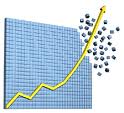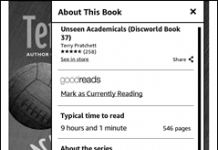 There is so much info here that the only thing to do is to reprint the press release pretty much in full:
There is so much info here that the only thing to do is to reprint the press release pretty much in full:
Millions of people are already reading on Kindles and Kindle is the #1 bestselling item on Amazon.com for two years running. It’s also the most-wished-for, most-gifted, and has the most 5-star reviews of any product on Amazon.com. Today, Amazon.com announced that Kindle device unit sales accelerated each month in the second quarter–both on a sequential month-over-month basis and on a year-over-year basis.
“We’ve reached a tipping point with the new price of Kindle–the growth rate of Kindle device unit sales has tripled since we lowered the price from $259 to $189,” said Jeff Bezos, Founder and CEO of Amazon.com. “In addition, even while our hardcover sales continue to grow, the Kindle format has now overtaken the hardcover format. Amazon.com customers now purchase more Kindle books than hardcover books–astonishing when you consider that we’ve been selling hardcover books for 15 years, and Kindle books for 33 months.”
Kindle offers the largest selection of the most popular books people want to read. The U.S. Kindle Store now has more than 630,000 books, including New Releases and 106 of 110 New York Times Best Sellers. Over 510,000 of these books are $9.99 or less, including 75 New York Times Best Sellers. Over 1.8 million free, out-of-copyright, pre-1923 books are also available to read on Kindle.
Recent milestones for Kindle books include:
* Over the past three months, for every 100 hardcover books Amazon.com has sold, it has sold 143 Kindle books. Over the past month, for every 100 hardcover books Amazon.com has sold, it has sold 180 Kindle books. This is across Amazon.com’s entire U.S. book business and includes sales of hardcover books where there is no Kindle edition. Free Kindle books are excluded and if included would make the number even higher.
* Amazon sold more than 3x as many Kindle books in the first half of 2010 as in the first half of 2009.
* The Association of American Publishers’ latest data reports that e-book sales grew 163 percent in the month of May and 207 percent year-to-date through May. Kindle book sales in May and year-to-date through May exceeded those growth rates.
* On July 6, Hachette announced that James Patterson had sold 1.14 million e-books to date. Of those, 867,881 were Kindle books.
* Five authors–Charlaine Harris, Stieg Larsson, Stephenie Meyer, James Patterson, and Nora Roberts–have each sold more than 500,000 Kindle books.

































A reminder that Amazon reports Q2 2010 earnings / performance results on Thu July 22.
This is impressive, whichever way you swing the cat. It is Kindle books, the so called “closed” standard vs every other vendor, many with a supposed “open” standard of DRM ePub. Yet best selling author James Patterson has sold 867,881 Kindle books and just 272,119 in ALL other formats combined.
Four other authors — Charlaine Harris, Steig Larsson, Stephenie Meyer and Nora Roberts — each also sold more than 500,000 Kindle books. Presumably, as with the case of James Patterson, they sold somewhere around 30% as many non-Kindle ebooks … or 150,000+ each.
And the Kindle book share is growing. Compared to both May sales and year-to-date sales ending May, Kindle grew faster than the market — this in spite of the onslaught of Nooks, iPads and Kobos which, even combined, lost ground.
Amazon also noted its sales of Kindle books exceeded hardcover books very significantly, in a trend that is growing the gap. Importantly, Amazon’s calculation excludes free books.
Amazon’s vision is to move the Kindle format (and experience) onto every logical platform; with significant segmented presence in domestic US, regional and global markets; in English and other languages; and link everyone back to a community experience driven by “always on” 3G connectivity.
Impressive. Good job, Amazon!
I wonder why Amazon is coming clean on the ebook sales numbers. Do they anticipate more of Apple’s funny accounting from last month?
They’re basically saying they control 80% or so of mainstream ebook sales which kinda puts Apple’s iBook claims to rest. (Unless B&N and the rest of the ADE gang actually have negative market share.)
Or maybe they’re looking to restablish their claim to industry leadership after having forced to *react* to B&N’s pricing moves.
Whatever the motivation, those are seriously impressive numbers and kinda put the challenge facing the ADE/epub gang into stark relief.
Hopefully B&N will put out a similar report so we may shed some more light into dark places.
It was a very smart move, prepping for the financial results we’ll hear about later in the week. Amazon needs to show, with unassailable authority, that it is making the right moves. The James Patterson stat is really enlightening: Amazon took a public number and revealed its own proprietary data demonstrating commanding leadership.
And it stuck with content — not devices. Amazon made no comment on its share of e-readers (or took the bait and compared itself to iPad sales) — just enough to say Kindles are the hottest item of anything Amazon sells. Content is where Amazon’s future lies and stats like these prove it has no need to “switch” to “open” formats like Adobe’s DRM ePub.
If this is Beta vs VHS, or Blu-ray vs HD DVD, Amazon is not selling Beta. (Oh, right … that was a Sony product … where is Sony these days in this market, content, devices or partnerhsips, anyway?)
Sony? They’re doing all of the above. Just not doing it well…
To be sure, these are very impressive numbers, but you have to take these things with a grain of salt. According to press releases, Amazon had >90% of the market share for e-books earlier this year (and has not lost market share), Apple and Barnes and Noble both have 20%. Also Sony has 8%, and Kobo exists. So that gives us 140%?
People have pointed out how Steve Jobs’ numbers are fuzzy, so I guess I should do the same here.
First up, Amazon is overstating the e-books over p-books angle by comparing Kindle sales to HARDCOVER only, not all p-book sales. Don’t paperbacks typically outsell hardovers on Amazon? Also, to make it sound like they are not just cannibalizing their own sales, Amazon states hardcover sales are still increasing. But they don’t state by how much, and they leave out the fact that industry-wide hardcover sales are up 50%! this year.
Second, the comparison between the AAP growth rate and the Kindle growth rate makes it sound like Kindle has somehow gained market share in spite of the IPAD. Ummmm… no. The AAP data only includes US sales (and only from some publishers), while Kindle is including in their number sales growth from their international expansion during the same time frame (as well as growth from self-published sales not included in the AAP data). Again, the successful international expansion is impressive, but these two statistics just aren’t comparable.
Third, what does “the growth rate of Kindle device unit sales has tripled” even mean? That could just mean that Kindle sales in June were 3% higher than sales in May, while sales in May were only 1% higher than sales in April.
I do wish someone would just release straight, comparable numbers.
To me the number that jumps out is clear and indisputable. Nothing fuzzy about “Patterson sold 1.14 million ebooks total of which 867881 kindle books”.
Those are absolute numbers, not lies and statistics.
So are five other top-selling authors tallying up half a million Kindle sales.
Those are mainstream sales numbers.
Numbers that say ebooks aren’t just selling to hobbyists or enthusiasts or techies.
90% last year? Maybe. Estimates and rumors. Nobody stood up with proof.
Amazon certainly wasn’t bragging. About that.
They are bragging now. If they’re lying, the SEC is going to be very interested…
The competition is on; Apple, Borders, and B&N have all made their moves and Amazon is still on top by a mile.
That is significant. Now to see what comes next.
@Peter: It sounds like you are trying to find controversy where there is none. You seem to be trying to trip Amazon up and tar them with the brush of possibly less honest competitors.
Amazon was crystal clear on its stats: they did not comment on pbook sales. They compared Amazon ebook and Amazon hardcover sales.
Amazon made the point their stats reflected paid ebooks, not free ones.
And they focused on ebook sales, not hardware: because ultimately Amazon shareholders care about ongoing, repeat and future revenues and those flow from buying the latest James Paterson thriller in volume, not manufacturing, shipping and servicing e-ink devices.
Of course, you can continue to try to find the dark lining in the silver cloud … but Amazon is doing very well selling ebooks, and that includes selling ebooks read on iPads.
These results are fantastic and will not surprise most people who own and love their Kindles (as I do). I also think, however, that Peter is correct to point out a couple of areas that are in danger of being misreported. Even on such a venerable blog as Teleread (one of my long-time favourites), the title of this post is wrong.
“…Amazon sells 180 ebooks for every 100 pbooks; Kindle sales triple…”
Bezos did not say that.
“…Over the past month, for every 100 hardcover books Amazon.com has sold, it has sold 180 Kindle books…”
And Kindle sales did not triple, but:
“…the growth rate of Kindle device unit sales has tripled since we lowered the price from $259 to $189…”
This could mean that they sold 100 units and then 101 making a growth rate of 1%. If they subsequently sold 103 this would be triple the growth rate. That statement – the use of the word ‘growth’ – was very deliberate. Most people are blind to such precision in language because they do not think mathematically. Amazon knows this.
I don’t think anyone is being pedantic or negative in trying to read the stats correctly. Amazon is not above trying to spin a story to their advantage (and why not?).
The truth is that these figures are brilliant but we should not blind ourselves by the glare.
Hats off to Bezos and the Amazon team.
Doh!
While in statistical pedant mode, I should point out my own error before someone else does:
For a triple growth rate in my example, 104 units would have to have been sold (up from 101).
I wonder, did this blogger actually read the press release he’s commenting?
Amazon does NOT sell 180 ebooks for every 100 pbooks.
Kindle sales did NOT triple.
The press release is very careful not to mention any expressive numbers. Instead, it suggests a lot using meaningless numbers. We have already seen what it wants to suggest and how easily people fall for it.
“the growth rate of Kindle device unit sales has tripled since we lowered the price from $259 to $189,”
Perfect example. If they had to lower prices their growth rate must have been very low. Triple that and they still have nothing to brag about. So little indeed, that they prefer not talking about actual sale numbers at all.
Think about it: After a > 25% price cut they can’t honestly volunteer a better statement than that! I just can see Steve ROTFLing. Why don’t they say how many percent more units they are selling? Why don’t they tell us why they were forced to drop the price in the first place?
“The Kindle format has now overtaken the hardcover format.”
The hardcover is a niche product with a much higher price point. Why don’t they compare ebook sales against all book sales? Think about that.
“the Kindle has the most 5-star reviews”
It is expected that, being the bestselling product, it gets the most reviews in any score. How do users review the Kindle compared to the average of all product reviews? Why don’t they tell you that?
“Over 1.8 million free, out-of-copyright, pre-1923 books are also available to read on Kindle.”
From Google, Internet Archive and Project Gutenberg. Available on all other platforms as well. No need to fiddle with USB cables or pay charges if you are using an Apple or Android device instead. They don’t tell you that.
If I might point out a couple more small bits of sleight-of-hand:
With the advent of the Agency Model, Hachette cut off sales through most outlets. During the time in question, Hachette titles were only available through Amazon, B&N, Apple, Sony, Kobo, and eBooks.com (in the US/Canada market). You can add Borders to that short list now.
Macmillan is in a similar situation, except that they aren’t even carried by eBooks.com.
Also:
Given the number of titles written by Charlaine Harris, James Patterson, and Nora Roberts, they don’t have to sell many of each title to reach that number.
Stieg Larsson is published by Random House, so prices of his e-books are lower. Stephenie Meyer is published by Hachette, where there aren’t a lot of other e-book outlets. Although I have to say, since Meyer hasn’t released a new novel (just a novella) recently, that’s a bit more impressive than the others.
Hardly that impressive….